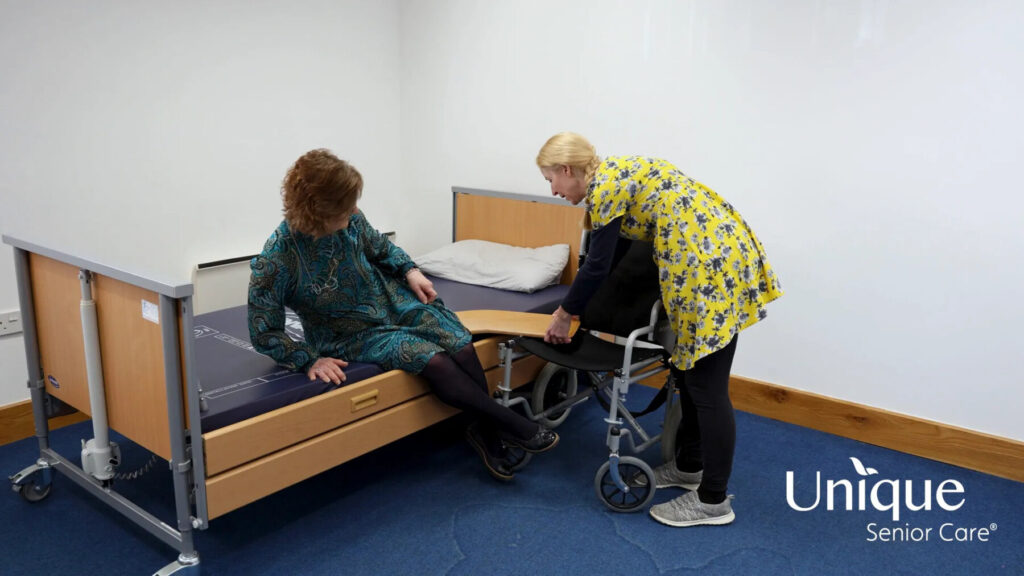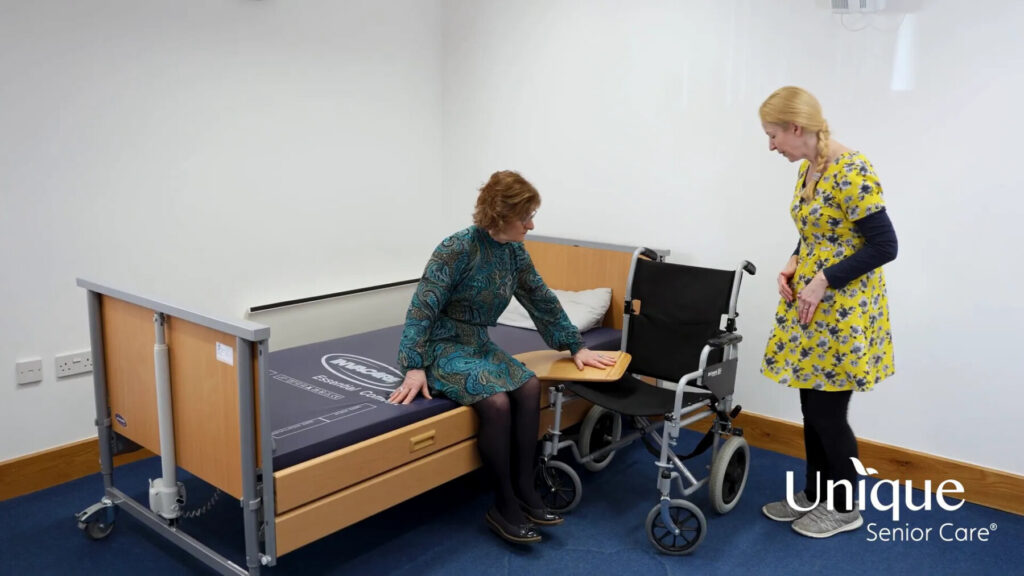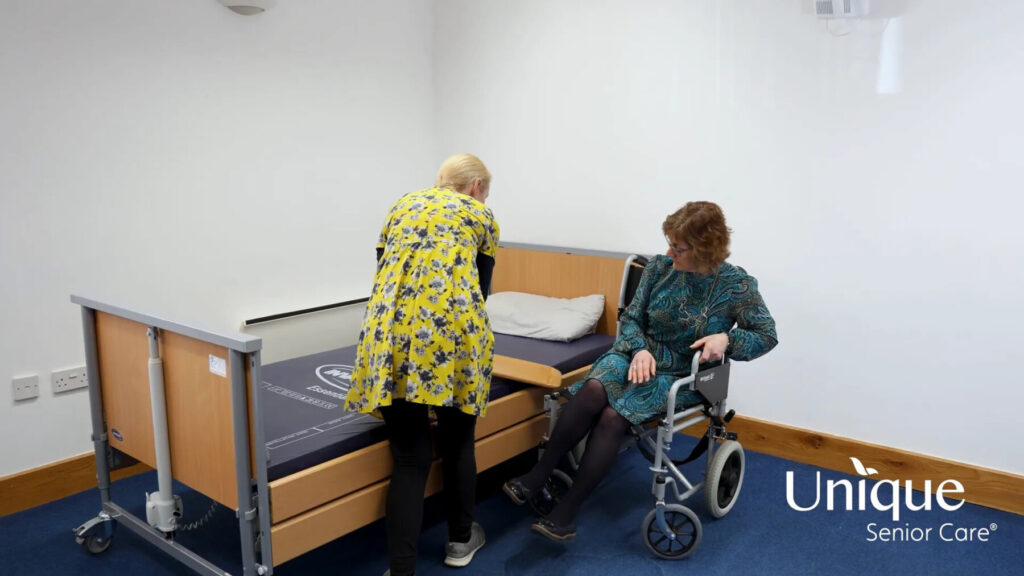Moving from bed to wheelchair is something many people need help with — whether every day or just now and again. In this guide, we’ll focus on how to use a transfer board, one of the most common and practical ways to support someone who isn’t able to stand. We’ll also briefly cover other options, like the rotunda, for people who can stand but need help turning or pivoting.
Whether you’re a family member or a Caregiver, using the right approach helps the person feel safer and more confident — and it also protects your back and joints while you support them.
Getting started: what to think about first
Before you help someone move, take a moment to think about how much support they actually need. Can they usually stand for short periods? Do they use a walking aid? Are they able to shift their weight, or will they need full support?
Everyone’s mobility is different, but here's a general guide to help you plan:
- Independent – Can move on their own, but might need a bit of encouragement or reassurance.
- Partially independent – Might need help with balance, positioning, or getting started.
- Dependent – Can’t stand or shift their weight without full support. Equipment will usually be needed here.
Getting a sense of where the person is on this scale helps you choose the safest, most comfortable way to support them.


When to use a transfer board
Transfer boards are ideal for people who can’t stand or bear weight but have enough upper body strength to shift themselves across. The board acts like a bridge between the bed and wheelchair, helping the person slide from one to the other without lifting.
They’re often used by:
- People with limited or no use of their legs.
- Individuals with good upper body control.
- Anyone who wants to remain as independent as possible during transfers.
Transfer boards come in a range of materials — some with slide sheets built in to make things smoother. One popular design is curved, often known as a banana board, which helps guide the movement.


How to position and use the transfer board
Here’s how to get the board in place without discomfort:
- Make sure the person is sitting securely near the edge of the bed.
- Ask them to lean slightly to one side so you can gently slide the board underneath one side of their bottom.
- Line the other end up with the wheelchair seat, so the surfaces are as level as possible.
- Avoid steep slopes — ideally, the board should be flat or just slightly angled to help with movement.
Watch out for hand placement. Fingers should stay flat on top of the board or resting safely on the surface they’re moving to — not tucked underneath, as they can get trapped or injured during the slide.
If the person is doing the slide themselves, they may not need much more than guidance and encouragement. If they need a bit of help:
- Ask them to lean gently towards the wheelchair, using their arms to push and shift across.
- Support their balance without pulling or dragging.
- Once seated, they can lean slightly the other way so you can remove the board easily and safely.


Other options: when to use a rotunda
While transfer boards are great for people who can’t stand, a rotunda is a better choice for someone who can bear weight but needs help with turning or balance.
You might use a rotunda if:
- The person can stand with support, even for a short time.
- They need help pivoting into position.
- They feel safer having something solid to hold while they move.
Make sure the rotunda is on stable ground, and always talk through the steps before starting the move.


Keeping yourself safe
Your posture matters just as much as theirs. To protect your back:
- Keep your spine straight and bend your knees slightly.
- Avoid twisting or overreaching.
- Let your legs and core muscles do the work, not your back.
Clear, calm communication also helps. Talk through each step and check they feel ready before you begin. A few words of encouragement go a long way.


What equipment can help?
Alongside transfer boards and rotundas, here are a few other things that can make transfers easier and safer:
- Grab bars: Fixed near beds or chairs to provide something stable to hold.
- Height-adjustable beds or chairs: Helps match surfaces more easily.
- Wheelchairs with removable armrests: Makes side transfers simpler.
- Slide sheets: Reduce friction and help with gentle repositioning.
Each piece of equipment should be chosen based on what the person can do and what makes them feel most confident.
Supporting independence
Even if someone needs help, try to involve them in the process as much as possible. Small actions — like shifting their weight or placing their hands — can make them feel more in control.
You can also:
- Encourage them to practise new movements with you nearby.
- Talk them through how and why equipment is used.
- Let them set the pace, especially on days when they feel more tired or unsteady.
Need more help or training?
If you're a family member of one of our clients and think you'd benefit from some extra support, we often have free spaces available on our Moving and Handling training sessions. Just get in touch with Jo Clearly at jo.clearly@uniquecare.co.uk to find out more.
You can also explore the rest of our Moving and Handling video series for more practical tips and step-by-step guidance.
FAQs: moving from bed to wheelchair
Talk through the steps and ask how they’re feeling before you start. Reassure them, involve them in the process, and move at their pace.
If they struggle to push themselves across, a transfer board may not be suitable on its own. Consider using a slide sheet or hoist, or speak to a professional about other safe options.
Ideally, the bed and wheelchair should be level, or the board should be on a very slight downward angle. Avoid steep slopes, which can lead to slipping or loss of control.
No — lifting puts you at risk of back injury and could hurt the person you're helping. Instead, guide and support them to use their own strength where possible, and use equipment if needed.
Watch carefully for hand placement. Make sure their fingers are flat on the board or the seat they’re moving towards — not curled around the edge, as this can lead to injury.
Take time to explain what the board is for and how it works. Offer reassurance and demonstrate if needed. If they still feel uncomfortable, don’t force it — look at alternative techniques or tools that might feel more natural to them.
Discover More Support & Information For Your Care Journey
Visit our Learning Centre for expert articles, helpful videos, in-depth guides, and answers to common questions - helping you make informed care decisions with confidence.
Explore NowJo joined Unique Senior Care as a Carer in 2011, transitioning from a nursing background. With 25 years of experience in health and social care, including mental health and children with disabilities, Jo has embraced numerous growth opportunities within the company.
Passionate about learning and development, Jo earned a Level 5 Diploma in this field and is committed to equipping teams with the skills needed for outstanding care.
Jo’s qualifications include advanced training in people handling, risk assessment, safeguarding, basic life support, first aid, health and safety, and dementia care. Jo has also completed numerous workshops and CPD courses, such as the SCIE’s Co-Production webinar.
These accomplishments reflect Jo’s dedication to fostering a culture of safety and excellence in care.


